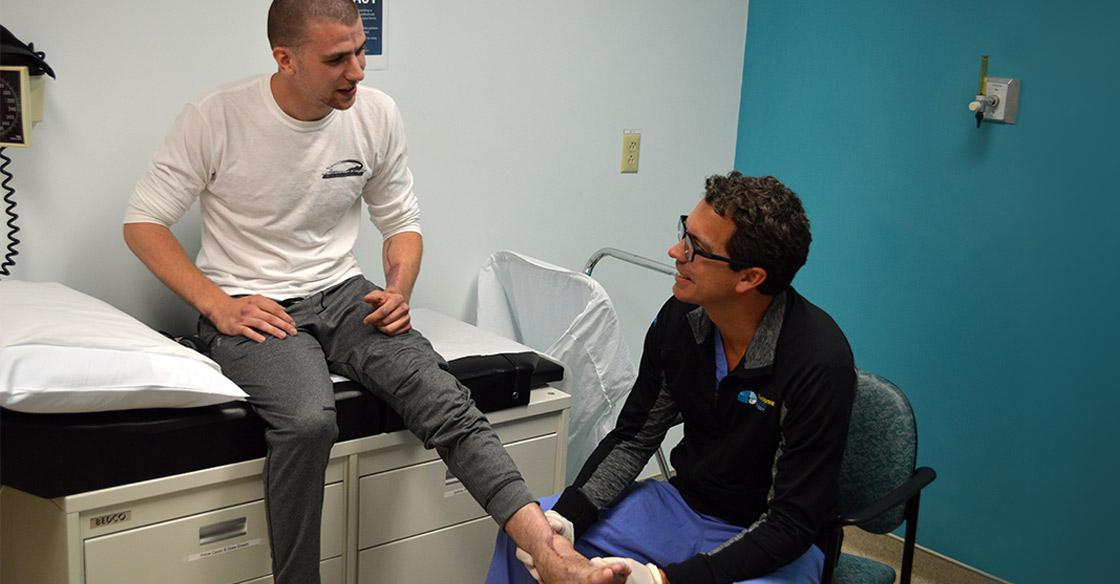
Dr. Jason Williams (right) conducts a followup exam with Gregg McCulloch (left). Gregg had reconstructive plastic surgery at the QEII to treat his injuries following a motorcycle accident.
Originally published on qe2times.ca.
Dr. Jason Williams knows his job can be misunderstood, not only by patients, but by many primary care physicians, nurses and medical students, so he enjoys any opportunity to educate others about the specialty he loves and devotes his working life to.
As one of six full-time and two part-time plastic surgeons at the QEII Health Sciences Centre, Dr. Williams is proud to represent a specialty that helps thousands of patients every year.
“In Canada, most plastic surgeons spend most of their time doing reconstructive and other insured surgeries,” says Dr. Williams. “Our focus is on fixing problems and improving the quality of patients’ lives.”
In 2013, Dr. Williams and some of his colleagues were on a mission to find out why plastic surgery is poorly understood — and they started with medical students. In their study, the team wanted to assess the perceptions of these students and explore what was influencing their beliefs, including the impact of media.
Across all four years at Dalhousie Medical School, 214 students participated in the study that began with an online survey. A second component included focus groups to obtain more detailed information about the factors influencing them.
As suspected, medical students showed a gap in knowledge when it comes to plastic surgery and television played a large role in shaping these perceptions.
“These misconceptions affect the specialty in several ways, from referral patterns by other physicians, to recruitment of medical students into residency programs, and even resource allocation within the system,” says Dr. Williams.
At the QEII, the plastic surgery team works collaboratively with other specialties such as orthopaedics, neurosurgery and general surgery — working together to restore form and function for patients who have experienced injury or illness.
Plastic surgeons work with many tissues, like skin, bones and nerves, to help repair or reconstruct the body. They perform procedures for everything from carpal tunnel syndrome and skin cancer removal, to hand and facial fracture repair, as well as breast reductions, breast reconstruction after mastectomies, care for complex wounds, such as pressure ulcers, and burn care.
“We work literally from head to toe,” says Dr. Williams. “Plastic surgeons are taught a set of techniques, which along with creativity and experience, allow us to help patients with a diverse array of problems.”
Gregg McCulloch is one such patient who benefitted from the team’s expertise.
An aviation technician with the Royal Canadian Air Force, Gregg was home for a few weeks and preparing to return to Europe, where he was posted. While enjoying a sunny commute on his motorcycle after work, Gregg was hit by another vehicle.
Gregg needed reconstructive surgery to save his left foot, which was so badly damaged the tendons and bones were exposed. He was surprised when he learned a plastic surgeon would do the surgery.
“I always thought of plastic surgery as body enhancement,” says Gregg. “I’d never known anyone with firsthand experience with plastic surgery.”
During what is called flap surgery, a piece of tissue with its attached blood supply is placed into an injured part of the body. Free flap surgery, which Gregg had performed, involves microsurgery to reconnect the blood vessels under a microscope. Dr. Williams performed a skin “free flap” from Gregg’s forearm to repair Gregg’s badly damaged foot.
“This type of reconstructive surgery is like a transplant with his own body,” says Dr. Williams.
Gregg was also treated for a cheek bone fracture by Dr. Justin Paletz, another member of the QEII plastic surgery team. This involved putting the broken bones back in their normal place and securing them with tiny plates and screws- all through hidden incisions.
Still working through his healing process, Gregg is happy to see he’s making progress and is grateful to the QEII’s plastic surgery team.
For Dr. Williams, it’s people like Gregg who keep them inspired.
“The QEII plastic surgeons are passionate about the work we do,” says Dr. Williams. “We are able to help patients and improve their quality of life every day.”